
Psoriasis (also known as lichen scaly) is a chronic skin disease that is not contagious and often recurrent.
Psoriasis, a symptom that determines its tendency to damage periarticular tissue, manifests itself in the form of scaly papules, in addition, it should be noted that the disease is one of the most common skin lesions that occur at any age.
The etiology of the disease has not yet been fully studied and proven, however, many dermatologists still agree that psoriasis is a disease directly related to genetic hereditary pathology.
Do not self -medicate. At the first sign of illness, see your doctor.
General description
Psoriasis is characterized by the duration and persistence of its own course. His pardon, which can last for months or years, meanwhile, indicates his next return and a period of a lifetime. Spontaneous cure of this disease is very rare.
If you try to determine a specific category of people who are prone to the onset of psoriasis, then the solution will not be clear. The fact is that psoriasis, acting as a systemic process, develops not only in people with actual immune disorders, but also in people with certain functional or morphological disorders related to the function of various systems and organs.
With respect to the dermatosis group, psoriasis is one of the most studied diseases in it. Meanwhile, no hypothesis that exists today can fully determine the essence of the disease. Given this, the problems associated with therapy and its prevention are in the same state of uncertainty and, at the same time, an acute state, as before. Depending on the particular time period, various ideas have been proposed about the origin of psoriasis. This, in turn, leads to the selection of several forms, each of which is based on the results of specific laboratory studies and clinical observations.
- The hereditary nature of the disease. This implies the presence of psoriasis in the framework of the consideration of several generations, in which, thus, cases of the disease have been recorded. In this way, it is hereditary that is considered to be practically the main and reliable cause of the development of psoriasis (in this case, psoriasis increases under the influence of various types of provoking factors).
- The metabolic nature of the disease. In this case, disturbances in fat metabolism (i. e. , in cholesterol metabolism), reduced morbidity during periods of starvation, increased amount of phosphorus in the psoriatic scale, etc.
- The viral nature of the disease. In this case, the concept of direct involvement of viral infection in the etiology of the disease under consideration was formed on the basis of numerous and long -term clinical observations. Accordingly, for the same reason, the infectious (as well as viral) nature of the theory of psoriasis development is the most ancient. So, the end of the 19th century was marked by cases of the formation of a very wide group of formations of the psoriatic type, formed against the background of patients suffering from diseases such as scarlet fever and influenza. The systemic nature of the actual lesion, its recurrent and prolonged course, the presence of contact with meteorological and heliophysical factors, as well as certain features inherent in the evolution of psoriatic rash features, also act as confirmation of the infectious nature of psoriasis. disease. Currently, a search is underway for viral agents through which the psoriatic process can be triggered.
- The endocrine nature of the disease. The theory of a direct link between the onset of psoriasis and endocrine (as well as metabolic) properties in the past has recently been supported by many. When examining patients with psoriasis, certain disorders in the endocrine scale are quite frequently revealed, which serves as a justification for the relevance of such connections. In particular, disorders related to functional conditions inherent in the sex glands, the influence caused by the menstrual cycle, pregnancy, childbirth and lactation, the types of significant changes detected in the study of the pituitary-adrenal system of patients have been highlighted.
- The neurogenic nature of the disease. It consists of the onset of the disease against the background of actual nerve shock for the patient (more precisely, after it is transferred). In about 30% of cases, disease exacerbation occurs precisely based on stress. In this case, the patient has a reduced ability to withstand the effects of stress and subsequent transfer as a result. At the same time, the disorders they experience (asthenic, vegetative-vascular-visceral, vegetative-vascular-dystonic and asthenodepressive) in combination with neurotic responses trigger the formation or even exacerbation of the vicious circle features that occur.
Welding
As we have mentioned, psoriasis acts as a chronic and recurrent disease. Any pre-existing form can be associated with one of the relevant classification variants for psoriasis, where there is a distribution for purulent or non-purulent psoriasis. In general, the classification is as follows:
- Psoriasis pustular
- generalized psoriasis;
- annular psoriasis (annular pustulosis);
- palmoplantar psoriasis (foot psoriasis, persistent palmoplantar pustulosis, barbera pustular psoriasis);
- chronic forms of persistent acrodermatitis (psoriasis of the feet and palms, palmar-plantar psoriasis);
- herpetiform psoriatic impetigo.
- Psoriasis is not pustular
- psoriasis vulgaris or psoriasis vulgaris, simple psoriasis (plaque, stable psoriasis in chronic form);
- psoriatic erythroderma (erythrodermic psoriasis).
A number of authors adhere to the need to add to this classification, as the type or form of psoriasis can be added to it in the following variants:
- psoriasis such as seborrhea (psoriasis seborrhea);
- psoriasis napkins;
- drug -induced psoriasis;
- "Reversible psoriasis" (psoriasis of skin folds, flexor surfaces).
Psoriasis: symptoms
The first symptom of psoriasis is a miliary papule type rash, characterized by a gradual increase along the edges, simultaneously turning them into nummular and lenticular papules and merging with each other, caused by plaques of various sizes appearing. The development of psoriasis in the skin defines three main stages for it.
First stage
This stage is defined as a progressive stage, it is caused by the formation of new formations on the skin (actually papules), as well as an increase in the size of existing formations on the skin. This is also accompanied by the formation of erythematous borders around the lesion (such borders are defined as peripheral growth zones). Plaques along the edges are not prone to exfoliation, while exfoliation, acting as the final stage of inflammation, does not coincide with the growth process of psoriatic formation.
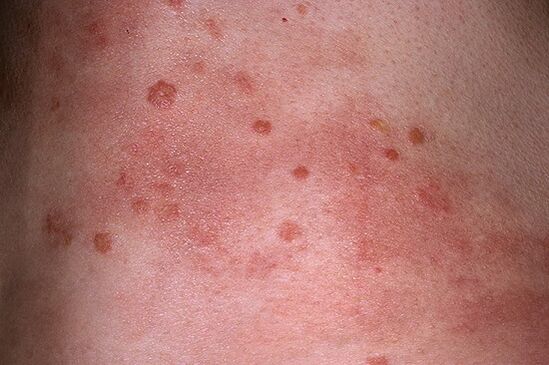
The second level
The second stage defines a stationary period in which new elements do not appear, however, existing elements in the form of plaques and papules do not change in size. In general, the appearance of papules can be resolved in any stage, therefore the stationary period may be accompanied by the simultaneous appearance of miliary papules, lenticular and nummular papules. Let us explain what are the three types of papules listed. So, nummular papules are round skin rash elements with a diameter in 15-20 mm (for this reason, these papules are also called coin-shaped). Lenticular papules are rash elements, flat or convex, oval or round, resembling lentils. And, finally, the miliary papule, which has the shape of a conical element and is thus similar to flaxseed. Basically, these papules are small in size, the main area is near the hair follicles.
The third level
This rating is inverse (or regressive). Its main feature is that the rash gradually disappears, and a whitish border of the pseudosclerotic type is formed around the foci itself (it is defined as a Voronov rim). During this period, some patients may experience mild itching. As for any subjective sensations, they are mostly expressed insignificantly, or even not present at all.
The appearance of the rash can be observed in any area of the skin, however, it is mostly localized on the surface area of the limb bends, in particular, elbow and knee joints, sacral area, scalp (here, in particular, areas along the edges of hair growth are distinguished, whichdefined as "psoriatic crown"). Psoriasis on the head, the symptoms of which, although determined by the severity of their own manifestations, do not lead to changes in the structure of the hair, as well as their loss.
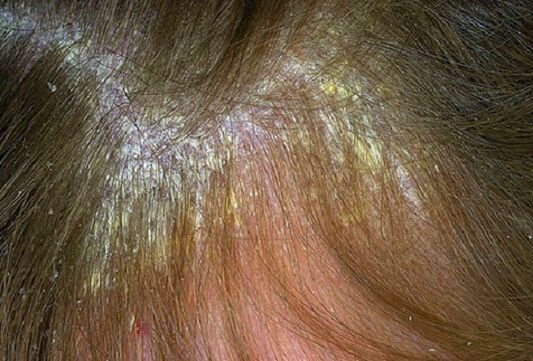

As for the concentration of plaque in the extensor surface of the knee and elbow joints, here it often persists for a long time from the moment the rash disappears in general (this feature defines it as a "task" plaque. Some patients are faced with the fact that the skin folds in the groin-femoral areaor mammary glands, as well as in the axillary glands, are affected, and often such lesions can be isolated.
Irritant psoriasis
It develops against the background of active exposure to the skin with pre -existing progressive psoriasis of certain irritants, in particular, sunlight or certain ointments, as well as other types of irritants that affect plaque. These plaques, in turn, become more convex in shape, the color changes to cherry red, a hyperthermic belt is formed in the surrounding area, which causes the sharp borders to become somewhat blurred. This belt, according to the resolution of the plaque, looks wrinkled.
psoriasis spots
This form of the disease manifests itself in the form of mild infiltration (in the general definition, infiltration is the impregnation of tissue with one or another substance) of the elements of the rash. They, in turn, look like spots (not papules). Spotted psoriasis develops, as a rule, acutely, and is also characterized by similarities with toxidermia. As a primary method in disease differentiation, the definition of disease course correspondence with psoriatic triad features is used.
Old psoriasis
This form of the disease can be considered in terms of symptoms in the form of severe infiltration of the sides of the plaques, their general cyanosis, with hyperkeratotic or warty surfaces. These types of foci are very difficult to cure, and their transformation in the future into the formation of malignant tumors is not excluded (this happens rarely, but, unfortunately, it is not necessary to exclude this option).
Seborrheic psoriasis
This form of psoriasis, as the name implies, develops in patients with seborrhea that is already associated with them. The disease manifests itself from the scalp, in the area behind the auricle, in the chest, in the area of the nasolabial folds, in the subscapularis and the posterior scapular portion. The emerging psoriatic scales are subject to strong saturation with sebum, as they stick together and remain within the surface of the plaque, which, thus, allows the disease to simulate the picture features of seborrheic eczema.
Palmar-plantar psoriasis
The disease can manifest either in the form of common psoriatic plaques and papules, or in the form of hyperkeratotic formations resembling calluses and calluses. In some cases, psoriasis on the hands, the symptoms noted in this case on the palms of the hands (or on the feet - by definition, on the soles of the feet) are persistent, which manifests itself in the form of increased thickening or keratinization. . The boundaries of this type of lesion are characterized by clarity; in more rare cases, this form of psoriasis is limited to the appearance of large ring exfoliations.
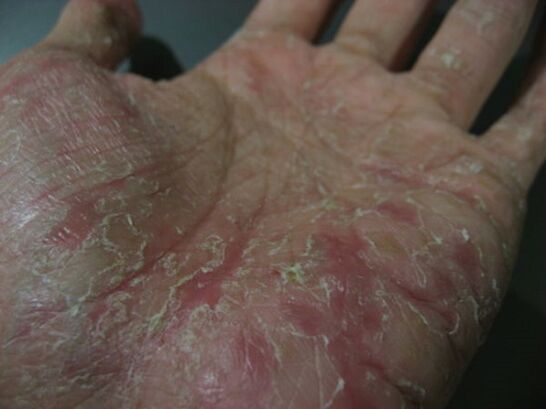

Exudative psoriasis
This form of psoriasis is characterized by excessive exudate severity during the inflammatory response; it appears in the progressive period of the course of psoriasis. Going to the surface of the papule, the exudate provides saturation of the accumulation of scales, thus forming from them a formation that looks like a crust. These elements are secondary, defining them as flakes-crust, the color of these elements is yellowish. After their removal, the slightly bleeding and weeping surface is subjected to exposure. The scaly crust, when dried and coated, often forms a large conglomerate type, resembling an oyster shell (this is already defined as rupioid psoriasis).
Psoriasis Guttate
Guttate psoriasis, a symptom that appears suddenly, is characterized by the formation of multiple spots in the skin. Most of these diseases are diagnosed in patients aged 8 to 16 years. Often, streptococcal infections act as a precursor to psoriasis in the form of teardrops.

Nail psoriasis
Nail psoriasis, a symptom that provides isolation of the type of psoriasis in three main forms, depending on the degree of nail damage, it can be atrophic, spot or hypertrophic.
Punctate lesions are thought to be the formation of punctate indentations on the nail plate, which can also be compared to the surface of a thimble. The manifestation of this form of psoriasis may be in a slightly different version, which, in its specificity, is similar to onychomycosis. In this case, inside the free edge, the nail plate changes color, becomes dull, prone to collapse without much effort. As a possible sign to distinguish psoriasis, inflammatory boundaries formed along the edges of the affected nail plate area were determined. It is presented as the edge of a papule in the nail bed, visible through the nail plate.
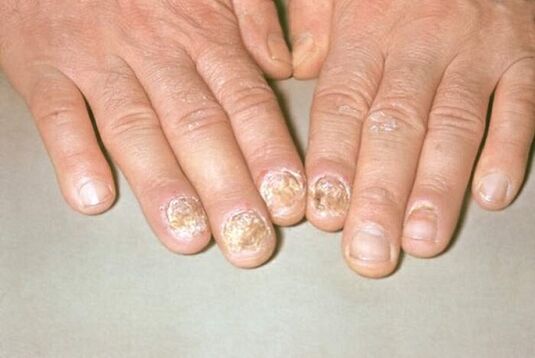
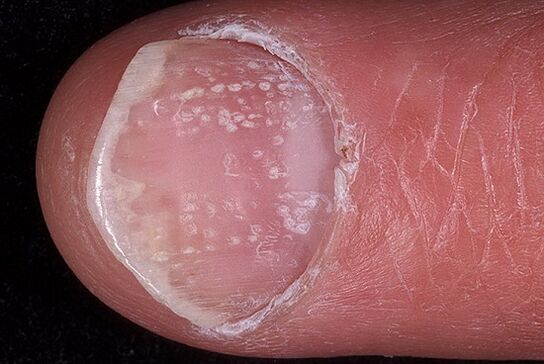
Psoriatic (psoriasis) arthritis
Psoriasis arthritis, a symptom manifested as a result of infiltration, associated with periarticular tissue with simultaneous damage to the joints, mainly affects the interphalangeal joints. Meanwhile, the possibility of large joint involvement in pathological processes is not excluded; The joints and articulations of the sacroiliac spine are very rarely at risk in this regard.
It is important to take into account that psoriatic arthritis, unlike other types of arthritis (which in the general definition means inflammation of the joints), is formed against the background of psoriatic rash that already exists in patients, often combined with nail damage. . In addition, an important point can be distinguished that the onset of this type of arthritis is combined with the exacerbation of psoriasis in the skin, which, in most cases, acquires an exudative character.
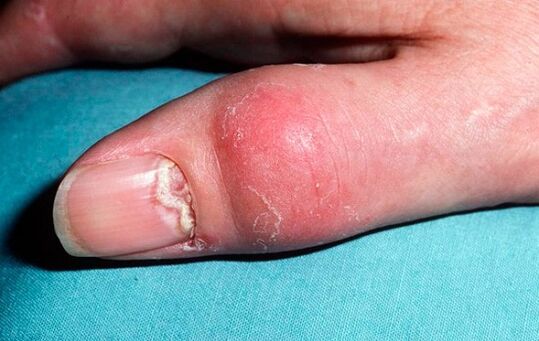
Irrational treatment of the disease during the period of its development is often accompanied by the occurrence of nonspecific reactions from the body. It is toxic-allergic and consists of the appearance of redness in areas not affected by psoriatic plaques, this redness, combined, affects the skin completely. This process is combined with high temperatures (in the range no higher than 39 degrees), as well as an increase in lymph nodes, a feeling of tight skin, burning sensation and itching. In frequent cases, there is also extensive exfoliation, thickening and peeling of the nail plate, hair loss. This picture already shows the association of psoriatic erythroderma. Erythroderma ends with the recovery of the traditional version of the psoriasis course.
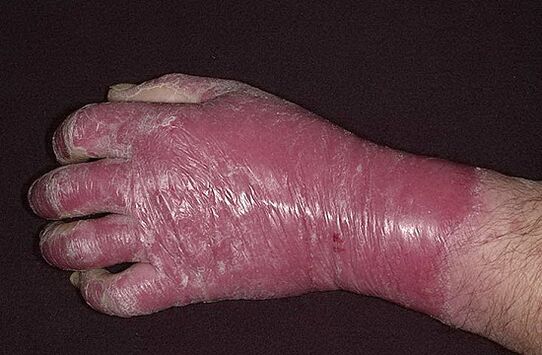
In general, recurrence of the disease occurs in autumn-winter, as well as in the spring-summer period, which is an important factor to take into account, including when prescribing the necessary treatment.
Psoriasis treatment
Before the appointment of treatment, a thorough examination of the patient is carried out, and already to determine the specific measures in it, they are based on the stage of the disease course, on its clinical diversity, the general condition of the patient, on the presence of concomitant diseases, suitability of disease manifestations to seasonality, etc. most quickly, and, at the same time, favorable treatment results are achieved in cases of uncomplicated forms of psoriasis with their short course, as well as with limited manifestations. In general, the treatment of psoriasis is a rather laborious process, and in most cases it is not possible to completely cure - the disease is only regressive (i. e. , the period of its existence without symptoms begins), which, however, is also a positive outcome for him.
The main goal in treatment is determined as the maximum possible suppression of symptoms in combination with the addition of preventive measures.
First of all, with psoriasis, a diet is prescribed, in which foods that give rise to the severity of the disease (spicy foods, chocolate, alcoholic beverages) are excluded from the diet. The restriction also applies to the consumption of smoked meat, honey, fried and fatty foods, etc. During the period of exacerbation of the disease, it is recommended to eat more fruits and vegetables (with the exception of red ones: apples, tomatoes, cherries, etc. ), fish and lean (boiled) meat.
The course of psoriasis has a good effect on its treatment in the conditions of sanitary resort facilities. Taking into account the special susceptibility of the skin in patients with psoriasis, it is recommended to avoid exposure to the sun on it within 11 to 16 hours.
For the drug treatment of psoriasis, it is based on the use of several methods. First of all, these are external agents (creams, ointments, etc. ), systemic treatment drugs (injections, pills, etc. ) and methods such as phytochemotherapy (phytotherapy), physiotherapy, and other methods of external treatment. In particular, the following drugs are most commonly used among them:
- Salap salicilik. With its help, softening of the formed scales is ensured, which in turn, gives the possibility of their early elimination together with better absorption of other types of drugs. This ointment (0. 5% or 5%) is applied to the affected skin area in a thin layer, 1-2 times a day. An important feature of the application is the use of a smaller amount of ointment with significant inflammatory properties (i. e. , the more inflammation is more pronounced in the nature of its manifestation, the less amount of ointment is applied to it, respectively). Salicylic acid, which acts as the basis of the drug, is also found in some other ointments used in the treatment of psoriasis.
- Sulfur tar ointment (5 or 10%). The use of this ointment provides a reduction in inflammatory processes associated with the skin. Contraindications to use are exudative psoriasis (i. e. psoriasis, accompanied by weeping crusts and scales). You should not use this ointment on the skin of the face. Tar shampoo is used to treat scalp psoriasis.
- Naphthalene ointment. It is used to treat the regressive and stationary stages of the disease. The severity or progression of psoriasis determines the unacceptability of using this drug. With the help of this ointment, intense itching and inflammation are reduced. 5% or 10% ointment is used.
- Glucocorticosteroid drugs. Their use gives a decrease in the intensity of inflammation. They are used only in short courses, with mandatory expert supervision.
- Ointments containing vitamin D. Such ointments provide anti-inflammatory effect, while at the same time they improve the course of the disease.
For systemic treatment, it is chosen strictly individually and only by the attending physician. As already mentioned, this means the use of various pills, injections, etc.
Phytochemotherapy as a method of treating psoriasis consists of ultraviolet exposure to the affected skin area. For this, a special type of installation is used, which illuminates the area without affecting healthy skin.
In general, psoriasis treatment can mean many different schemes implemented in practice, but none of these schemes are generally accepted because of differences in course and specificity, therefore the effectiveness of any scheme cannot be determined equally for all patients. Let us repeat that the treatment of the disease is carried out individually under the constant supervision of the attending physician.
If symptoms appear that indicate psoriasis, it is necessary to contact a dermatologist and an infectious disease specialist.























